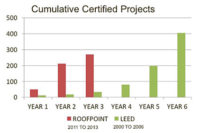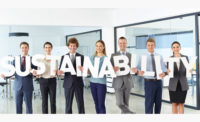Summing Up Sustainability With RoofPoint

Every year in the United States more than 3 billion square feet of nonresidential roofs are installed on new and existing buildings. If these roofs were installed using the best energy guidelines available today, the first-year savings in heating and cooling demand would exceed 36 trillion BTUs. The cumulative energy savings after 10 years would exceed 2 quads — the equivalent of 72 million tons of coal. In addition to significant energy savings, broad adoption of the best available sustainable roofing practices would deliver many additional benefits:
• Clean rooftop energy exceeding the capacity of 25 Grand Coulee Dams.
• Improved urban air quality and reduced storm water pollution.
• Less construction waste sent to landfills.
• Increased building service life.
• Enhanced building occupant safety, health and productivity.
Unfortunately, no green rating system exists to release the massive energy and environmental promise of commercial roofs … until now. In an effort to tap this unrealized potential, the Center has developed RoofPoint, a green rating system to help building owners and designers select roof systems based on long-term energy and environmental benefits. RoofPoint features 24 specific strategies to address all critical environmental aspects of modern roofing systems. These strategies are scored against measureable goals, and the achievement of each roofing project is summarized as a total point score. Roofing projects meeting a minimum score overall and in each major category are then recognized as registered RoofPoint roofs — roofs that embody the key principles of sustainable roofing.
For building managers and designers, RoofPoint streamlines the roofing decision process by offering a simple template for effective roof system selection, validating all aspects of sustainable roof asset management, and providing a non-proprietary framework for roof system selection that emphasizes flexibility and choice. And for the roofing contractor, RoofPoint provides a useful selling tool and checklist to identify all key aspects of sustainable roof material selection, while emphasizing critical installation skills and validating the ongoing maintenance services provided by the contractor that help to ensure long-term roof sustainability.
As part of this year’s IRE educational program, the Center will present an informational session on how the key principles of RoofPoint can be used to secure new business opportunities and grow roofing profits. I hope you’ll be able to join us on Friday, Feb. 24 at 9:30 a.m. for “Moving Green into the Black: Proven Strategies to Profit from the Green Building Movement.” During this session, you’ll learn more about how the RoofPoint program works and how you can use it to build strong relationships with your customers and a solid reputation for your business. If you can’t join us, please visit the new RoofPoint website, www.roofpoint.org, to learn more about RoofPoint and how your company can participate in the RoofPoint program.
And whether you attend our IRE educational session or check out the new RoofPoint website, I hope you will join some of the best roofing contractors across North America currently participating in the RoofPoint program. It’s easy and simple. In fact, many contractors have advised us that filling out the RoofPoint evaluation form is as easy as filling out a manufacturer’s warranty application. And the benefits for you and your customers are outstanding: achievement certificates, positive press coverage, and a chance to show how the roofing industry is making a difference in our environment. Please join us!
Looking for a reprint of this article?
From high-res PDFs to custom plaques, order your copy today!






